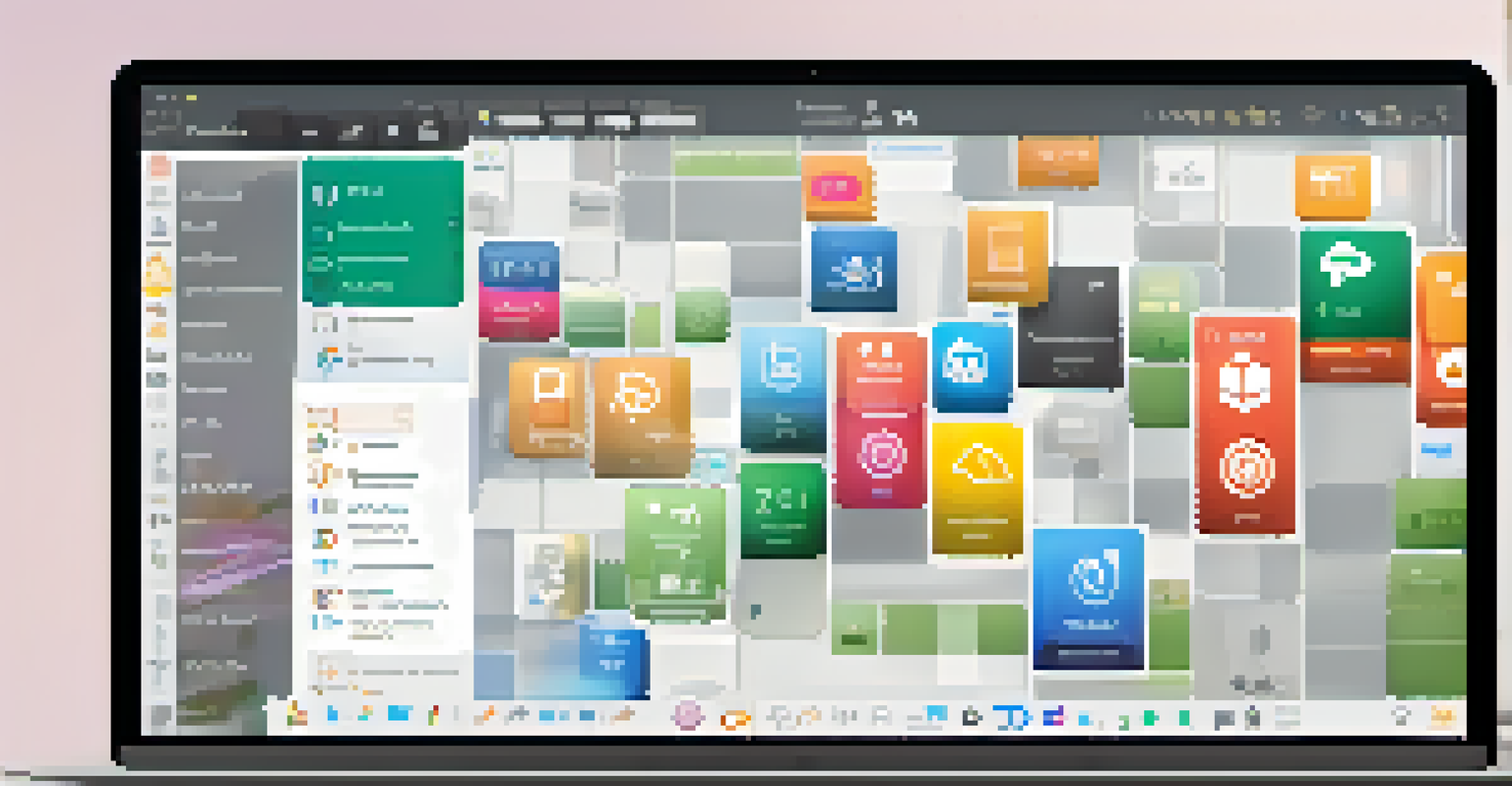Future Trends in Digital Collaboration Technologies

The Rise of Artificial Intelligence in Collaboration Tools
Artificial Intelligence (AI) is transforming digital collaboration by automating repetitive tasks. Imagine a virtual assistant that not only schedules meetings but also summarizes discussions and highlights action items. This smart technology can significantly enhance productivity, allowing teams to focus on more strategic aspects of their projects.
Collaboration allows teams to leverage each other's strengths and accomplish more than they could alone.
As AI continues to evolve, we can expect it to analyze team dynamics and provide insights on improving communication and collaboration. For example, AI could suggest the best times for meetings based on team members' schedules and past interactions. This personalized approach can help streamline workflows and foster better teamwork.
Moreover, AI-driven tools can facilitate language translation, making collaboration easier for global teams. This means that language barriers will diminish, allowing for seamless communication across different cultures. In a world that increasingly values diverse perspectives, this technology will be key to driving innovative ideas and solutions.
Virtual and Augmented Reality: A New Dimension of Collaboration
Virtual Reality (VR) and Augmented Reality (AR) are stepping into the spotlight as powerful tools for digital collaboration. Imagine a team of architects collaborating in a virtual space, walking through a 3D model of their design, discussing changes in real-time. These immersive experiences can enhance understanding and creativity, leading to more innovative outcomes.

AR can also overlay digital information onto the physical world, allowing team members to visualize data in context. For instance, a technician could see schematics projected onto a machine, facilitating maintenance and training. This hands-on approach can improve learning and retention, making collaboration more effective.
AI Enhances Team Productivity
AI tools automate tasks and analyze team dynamics, allowing teams to focus on strategic collaboration.
As technology advances, we can anticipate more affordable and accessible VR and AR solutions. This will democratize access to these tools, enabling businesses of all sizes to leverage immersive collaboration. Ultimately, this shift could redefine how teams interact, breaking down geographical barriers and creating a more inclusive work environment.
The Growth of Asynchronous Collaboration
Asynchronous collaboration is gaining traction as teams become more distributed and flexible. Unlike traditional models that rely on real-time communication, this approach allows team members to contribute at their convenience. Picture a scenario where colleagues across different time zones can collaborate through shared documents and recorded meetings, ensuring everyone stays in the loop.
The best collaboration tools are the ones that feel like an extension of the team, blending seamlessly into their workflows.
This flexibility not only accommodates various working styles but also promotes a healthier work-life balance. Teams can engage in deep work without the constant interruptions of live meetings. Moreover, this method encourages thoughtful contributions, as individuals have time to reflect on their input before sharing.
However, successful asynchronous collaboration requires clear communication and organized workflows. Tools that facilitate this process, like project management software and collaborative platforms, will become increasingly essential. As more organizations adopt this trend, we'll likely see a shift in how teams measure productivity and collaboration success.
Enhanced Security Measures for Digital Collaboration
As digital collaboration tools proliferate, so do concerns about security and data privacy. With sensitive information being shared across platforms, organizations must prioritize robust security measures. Think of it as locking your front door; just as you wouldn't leave your home unprotected, you need to safeguard your digital spaces.
Emerging trends include end-to-end encryption and advanced authentication methods, ensuring that only authorized users can access sensitive data. For example, multi-factor authentication adds an extra layer of security, requiring users to verify their identity through multiple channels. This proactive approach can help prevent unauthorized access and data breaches.
Niche Platforms for Specific Needs
Specialized collaboration tools cater to unique industry requirements, enhancing productivity and efficiency.
Furthermore, organizations are increasingly focusing on employee training regarding cybersecurity best practices. By educating teams about potential threats and how to mitigate them, companies can foster a culture of security. As a result, we can expect a more vigilant approach to digital collaboration, where security is woven into the fabric of everyday practices.
The Role of Cloud-Based Collaboration Tools
Cloud-based collaboration tools are becoming the backbone of modern teamwork, providing access to documents and resources anytime, anywhere. This flexibility allows team members to work from various locations, making remote collaboration seamless. For instance, platforms like Google Workspace and Microsoft 365 enable real-time editing and feedback, bridging the gap between team members.
The cloud also facilitates easy integration with other tools, creating a cohesive ecosystem for collaboration. Imagine a project management tool that syncs with your communication platform, automatically updating tasks based on discussions. This interconnectedness streamlines workflows, reducing the friction often associated with switching between applications.
Looking ahead, we can anticipate further innovations in cloud technology, such as enhanced storage solutions and improved user interfaces. As these tools become more sophisticated, they will empower teams to collaborate more effectively, fostering creativity and innovation. The cloud is not just a trend; it's a fundamental shift in how we approach teamwork.
The Emergence of Niche Collaboration Platforms
As the digital collaboration landscape evolves, we're seeing the rise of niche platforms tailored to specific industries or functions. These tools address unique needs that broader applications may overlook. For instance, a platform designed for creative teams might focus on visual collaboration, allowing designers to share and iterate on graphics seamlessly.
By honing in on particular sectors, these niche platforms can offer specialized features that enhance productivity. For example, a collaboration tool for software developers may integrate coding environments directly into the workspace, streamlining the development process. This targeted approach allows teams to work more efficiently and effectively.
User Experience Drives Adoption
An intuitive user experience is crucial for the successful adoption of collaboration tools among team members.
As organizations seek to optimize their collaboration efforts, we can expect increased investment in these specialized tools. This trend will likely lead to a more diverse range of collaboration options, allowing teams to choose solutions that align with their specific goals and workflows. The future of collaboration is not one-size-fits-all; it's about finding the right fit.
The Importance of User Experience in Collaboration Tools
User experience (UX) is critical in driving the adoption of collaboration tools. If a platform is difficult to navigate or frustrating to use, team members are less likely to embrace it. Imagine trying to work with a complicated tool that adds more steps than necessary; it can quickly become a source of frustration rather than a productivity booster.
As we move forward, developers are prioritizing intuitive designs that enhance usability. This means creating interfaces that are easy to understand and navigate, minimizing the learning curve for new users. A well-designed tool allows teams to focus on collaboration rather than getting bogged down in technical difficulties.

Furthermore, gathering user feedback will play a significant role in shaping future collaboration tools. By understanding the needs and pain points of users, developers can create solutions that genuinely enhance teamwork. Ultimately, a positive user experience can lead to increased engagement and better collaboration outcomes.